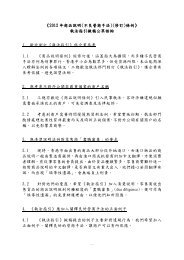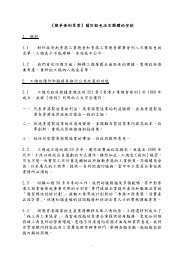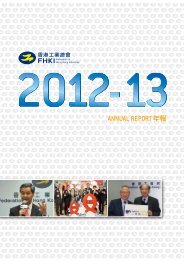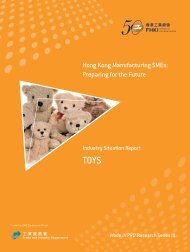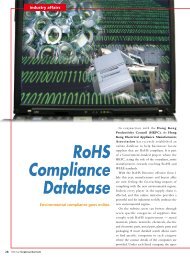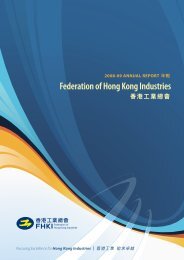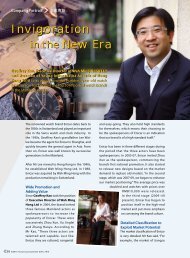Hong Kong Manufacturing SMEs: Preparing for the Future
Hong Kong Manufacturing SMEs: Preparing for the Future
Hong Kong Manufacturing SMEs: Preparing for the Future
- No tags were found...
Create successful ePaper yourself
Turn your PDF publications into a flip-book with our unique Google optimized e-Paper software.
49that it is unlikely production would leave China,eventually such costs should result in higher prices.However, individual firms (particularly <strong>SMEs</strong>) findit difficult to pass on cost increases in <strong>the</strong> face ofpowerful buyers, as <strong>SMEs</strong> find it more difficultto take on <strong>the</strong> added administrative burden thanlarger firms, and some <strong>Hong</strong> <strong>Kong</strong> companiesbelieve that Mainland Chinese firms are able (orwilling) to skirt <strong>the</strong> Law. As a result, <strong>the</strong> <strong>Hong</strong><strong>Kong</strong> <strong>SMEs</strong> are disproportionately disadvantagedby its implementation. Since <strong>the</strong> impact should begreatest <strong>for</strong> <strong>the</strong> most labour intensive industries,<strong>the</strong> impact of <strong>the</strong> Law on <strong>Hong</strong> <strong>Kong</strong>’s watch andclock companies is likely to be middling comparedto o<strong>the</strong>r industries, with more labour-intensiveindustries like garment and toy more affected, andless labour-intensive industries like mould and dieless affected.The watch and clock industry has been subject topressure to move out of <strong>the</strong> Pearl River Delta or outof Guangdong completely under <strong>the</strong> Ministry ofCommerce’s “Opinion on Supporting <strong>the</strong> Middleand Western Regions’ Reception of Processing TradeRelocation” (November 2007) 106 and Guangdong’s“Decision on Promoting <strong>the</strong> Relocations ofIndustries and Labour Force.” 107 Such relocation isproblematic because watch production dependson a dense supply network. <strong>Hong</strong> <strong>Kong</strong> watchfirms are attracted to <strong>the</strong> PRD due to <strong>the</strong> presenceof a complete network of suppliers of parts,components, and services such as electroplating.In an ef<strong>for</strong>t to encourage relocation, HepingCounty (Heyuan, Guangdong) and Shenzhenjointly established a watch industry relocation parkin 2006 with an investment of RMB 8 billion. Thepark, which aims to attract 200 firms and to provide100,000 jobs, has planned a centralised testingcentre and a centralised electroplating facility (mostwatch components need to be electroplated) tominimise pollution. As of mid-2009, 41 watchfirms were located in <strong>the</strong> Park, but relocations hadslowed due to <strong>the</strong> financial crisis. It is yet to be seenwhe<strong>the</strong>r <strong>the</strong> park will result in large scale movementof <strong>the</strong> industry from Shenzhen, or whe<strong>the</strong>r it willresult in consolidation of <strong>the</strong> industry, but it is clearthat <strong>the</strong> overall policy direction is to move watchproduction out of <strong>the</strong> core areas of <strong>the</strong> PRD.Response Strategies of <strong>Hong</strong> <strong>Kong</strong> <strong>SMEs</strong><strong>Hong</strong> <strong>Kong</strong> watch and clock manufacturers haveundertaken a variety of strategies to deal withrecent pressures. In general, <strong>Hong</strong> <strong>Kong</strong> watch andclock manufacturers are attempting to maintain<strong>the</strong>ir presence in traditional OEM manufacturingwhile at <strong>the</strong> same time trying to add value toexisting products, develop new high value addingproducts, develop <strong>the</strong>ir own brands, find newmarkets <strong>for</strong> <strong>the</strong>ir products, and work out <strong>the</strong>ir salesplans so as to achieve sustainable development. Wenote <strong>the</strong> following:• The downturn in traditional markets has led many<strong>Hong</strong> <strong>Kong</strong> firms to seek markets elsewhere,including Mainland China and <strong>the</strong> Middle East.For example, a 2008 survey by <strong>the</strong> HKTDC 108showed that 89 per cent of respondents wereoptimistic about <strong>the</strong> sales of watches to MainlandChina. Developing new markets takes time,however, and <strong>the</strong> scale of potential new marketseven if deeply penetrated does not currentlycompare to that of <strong>the</strong> existing European andAmerican markets.• Penetrating <strong>the</strong> China market will be difficult<strong>for</strong> many <strong>Hong</strong> <strong>Kong</strong> <strong>SMEs</strong>, because exportprocessing and OEM business is very differentfrom distributing and selling within China. <strong>Hong</strong><strong>Kong</strong> <strong>SMEs</strong> tend to be good at controlling costs,but are less knowledgeable about consumers,marketing, and distribution. Thus <strong>the</strong>y mayencounter difficulties in building a businessaround domestic sales in China unless <strong>the</strong>yreconfigure <strong>the</strong>ir business model.106 www.gov.cn107 www.gdsme.com.cn108 <strong>Hong</strong> <strong>Kong</strong> Trade Development Council, “Offshore Trade andProduction: Development and Implications” 5 February 2008.




